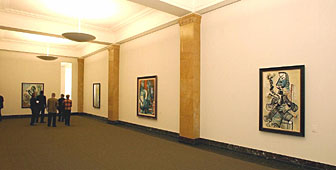Picasso and Klee see the light in Lucerne

A new museum housing works of art from some of the 19th and 20th centuries' most important artists has opened its doors in the heart of Lucerne.
The Rosengart Museum is the new home of art dealer Angela Rosengart’s personal collection, containing 200 works, 47 of them by Pablo Picasso and another 120 by Swiss artist Paul Klee. Other artists exposed in the former national bank building include Cézanne, Modigliani, Braque, Miro and Léger.
Seventy-year-old Rosengart decided a few years ago to make her private collection available to the public, creating a foundation to ensure its integrity after her death.
Treasured collection
“My father and I collected these works with much love and I didn’t want the pictures to be sold when I died,” she said. “Money doesn’t mean anything to me and I decided to make the collection public.”
To make the museum a reality, Rosengart also dug deep into her pockets, forking out SFr20 million ($12.06 million) to buy and renovate the building just a few minutes walk away from Lucerne’s main station.
According to art experts, the Rosengart collection compares favourably with others that have been made public in recent years. “In the context of recent private collections going public, it’s on the level of the Berggruen museum in Berlin or the Beyeler Foundation near Basel,” said Martin Kunz, a member of the Foundation board.
“I don’t think there is any other private collection which is publicly accessible with as many works by Paul Klee and Picasso. And there is no other anywhere in the world with such a good selection of late Picassos.”
The museum’s two main focuses, Klee’s career and Picasso’s work before and after the Second World War, may seem an odd choice at first, with the artists’ very different styles. But Angela Rosengart’s decision to concentrate on their production is not that unusual.
“Because of the high quality of their work, many private collections around the world put an accent on these two artists,” explained Toni Stooss, the former director of the Bern fine arts museum.
Mutual respect
The Rosengart collection also bears witness to mutual respect between the two artists according to Stooss.
“Picasso thought Klee was a great artist, but that his work had nothing in common with his own, and Klee probably could have said the same thing about Picasso. But they respected the high quality of each other’s work.”
The works on display in Lucerne represent first and foremost personal tastes.
“There is nothing intellectual about this collection,” Rosengart told swissinfo. “It is really the heart that spoke.
“These are pictures my father and I particularly loved, that we wanted to have them on our walls, to live with. That’s how the collection was formed, with no idea of actually creating it.”
Long acquaintance
Angela Rosengart didn’t just consider Klee and Picasso from afar either. She bought her first drawing by the Swiss artist at age 17, and her father first met the Spaniard back in 1914.
Picasso was more than an acquaintance for the art dealer. He painted her portrait five times, works that can be seen in Lucerne’s small Picasso museum, which benefited from earlier donation from the Rosengarts.
Despite its intensely personal approach, the collection should appeal to a wider public.
“Angela Rosengart had not thought at the very beginning that her collection would become public, but she was able to keep an elegant balance by emphasising its two pillars, Klee and Picasso,” said Stooss. “This is enough to satisfy public expectations, and there are also sufficient other works to create a framework around these two artists. “
Martin Kunz believes the new museum will have no trouble drawing visitors with its twin pillars of Picasso and Klee.
“Picasso will easily attract visitors,” he told swissinfo. “And if Klee is less well known, there is a huge public of connoisseurs who know if they want to see his work, they can go to Bern to the Paul Klee Foundation or they can come to Lucerne.”
If Angela Rosengart chose her paintings and sculptures with her heart, she remains proud that the art world’s experts later vindicated her good taste.
“I see that 30 years ago, people didn’t know about late Picassos, they didn’t enjoy looking at them,” she said. “But they have slowly discovered that our choice was the right one, so I’m very proud of my collection.”
Rosengart has been involved in all the phases leading to the opening of the museum, perhaps as some kind of compensation for her now empty home.
“The walls of my home are bare now,” she said. “Everything is I love is here in the museum.”
by Scott Capper

In compliance with the JTI standards
More: SWI swissinfo.ch certified by the Journalism Trust Initiative








You can find an overview of ongoing debates with our journalists here . Please join us!
If you want to start a conversation about a topic raised in this article or want to report factual errors, email us at english@swissinfo.ch.